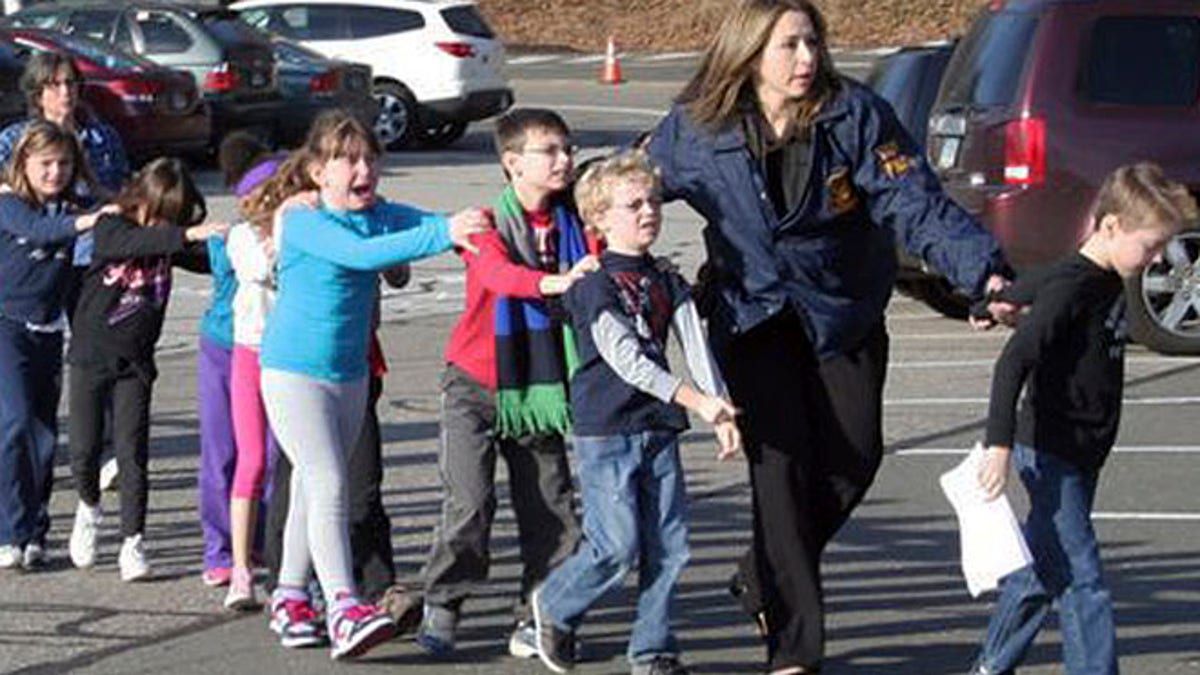
Dec. 14, 2012: In this photo provided by the Newtown Bee, Connecticut State Police lead children from the Sandy Hook Elementary School in Newtown, Conn., following a reported shooting there. (AP/Newtown Bee)
As we watch the news in the aftermath of the horrific Connecticut school shooting, we hear stories from the staff and students how the school was in "lockdown."
When asked by a reporter what that means, one parent replied, "I don't know exactly."
Lockdowns became commonplace in schools in the years after the 1999 Columbine shootings, in which 13 people were killed by two students, who then committed suicide. Each state's Department of Education has guidelines and mandates for school security drills, including fire, evacuation, and lockdown drills, on their websites. Schools do not typically post their procedures online as a security measure.
Lockdown drills are conducted in coordination with local law enforcement officials. Many police departments practice their response to such scenarios in schools after school hours to become familiar with the layout of the school and potential hiding spots for intruders.
In a lockdown situation, children are directed to the safest place in the room, typically a corner away from windows and out of the line of vision from the door. Doors are locked, window shades are pulled down, and lights are turned off by the teacher in the classroom.
A key component to a lockdown situation is the signal that the threat is over and students and staff may safely move from their hiding place. Some schools use a code word that only the staff and law enforcement know. Others signal the end of the lockdown by repeating a phrase over the loudspeaker a specified number of times. The verified signal that it is safe to come out ensures staff and students will be greeted by help, not harm.
Kaitlin Roig, the first-grade teacher who barricaded herself and 15 students in a bathroom, asked police to slide their badges under the door before she came out. This was an incredibly wise and safe decision on her part.
Schools don't always inform students of the details of the procedures, such as code words, under the belief that children may share that information with the public, which could ultimately compromise the procedure. Also, some schools believe in an actual emergency, students will respond to the adults' directions and don't need to be burdened with the details of the plan.
During a lockdown, whether real or practice, the teacher must remain calm. When I was teaching, I kept a box of books, fidget toys, paper and crayons in the corner where students and I would wait during lockdown drills. I knew if we had to stay there for a long time, we would need some resources to keep students calm and quiet. Staying quiet is important because the intruder may think the class is empty and move on. It also helps the students remain calm, and thus ready to receive your directions.
One important lesson to take from this horrific situation is to be prepared. Every room should have a key hung next to the door. Everyone should know that in an emergency, they can hide safely in a classroom by closing and locking the door. This needs to be standard protocol in all schools. Time spent looking for a key to lock a door or moving furniture to barricade the door can mean the difference between life and death. This will save lives and has clearly done so.
I was shocked to talk to an educator yesterday, speaking on the condition of anonymity, who was told by her administrators at the beginning of the school year there just aren't enough keys to go around. Since teachers in this school share classrooms, they are given keys to their main classroom, but not keys to other classrooms they may use during the day. This is unacceptable and could be remedied immediately by maintaining one key within the classroom at all times.
Another important component to the success of lockdown procures is they need to be practiced at various times throughout the school day, including arrival and dismissal, lunch and recess, and in between class periods, when students are walking the halls. A scenario where a shooter enters the school premise while students are at their desks in a classroom is very different from when students are outside at recess. Students and staff must know where to go and how to proceed when faced with a number of situations.
Though details are still emerging, it seems Sandy Hook Elementary school was well-prepared, utilizing a security system that required visitors to be granted access in to the building and practicing lockdown drills frequently. Though the thought that a tragic situation could still occur despite preparation is frightening, but it's clear that these preparations did save lives. Schools across the country must ensure their procedures are detailed and second nature for everyone within their walls.
